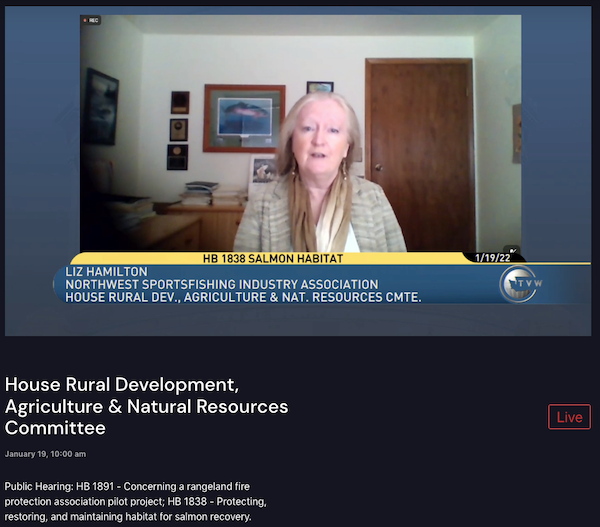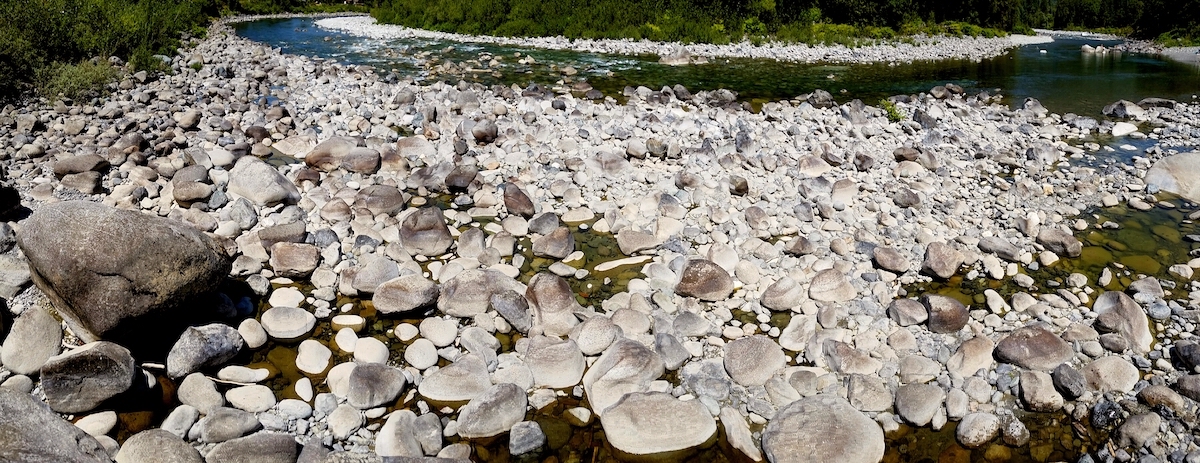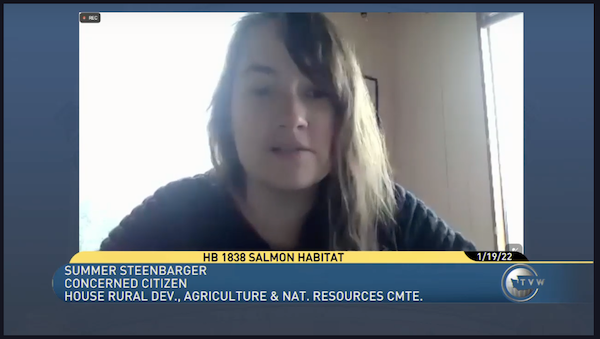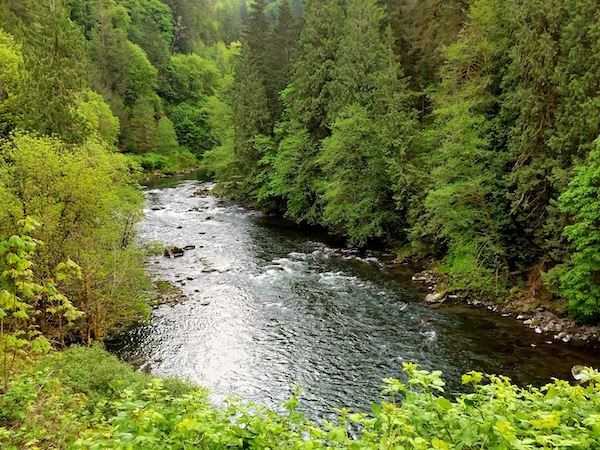
‘Ambitious’ Salmon Habitat Bill Gets Public Hearing
A sweeping if also contentious salmon riparian habitat protection and restoration bill drew support from a regional recreational fishing organization, tribal leaders and others during a hearing in Olympia this morning, but also strong opposition from farmers and some counties.
“Salmon and steelhead are the drivers in our industry; thus we are excited about the ambitious commitments to their recovery,” said Liz Hamilton, executive director of the Northwest Sportfishing Industry Association, about House Bill 1838.

She said that what’s known as the Lorraine Loomis Act, named after the longtime Swinomish and Westside tribal fisheries leader who passed away last August, provides “commitments for funding, habitat recovery and reducing stream temperatures that are too hot for salmon, with an emphasis on best available science and monitoring.”
The bill was introduced by Rep. Debra Lekanof, a North Sound Democrat and fellow Swinomish member, at the request of the Governor’s Office as a key element in Gov. Jay Inslee’s $187 million salmon strategy proposed last month, a budget and policy bid that includes adopting and enforcing riparian zone standards and allocating $100 million to a new grant program to help protect and restore these fish-critical areas.
Per WDFW’s supportive testimony today, riparian areas are critical for the shade, nutrients and stability they provide young Chinook, coho, steelhead and other species. Their importance was made clear during the Blob summer of 2015, which saw extremely low stream flows due to lack of winter snowpack as well as the loss of a quarter million returning adult sockeye in the Columbia.

If passed as written, WDFW would see somewhere north of $90 million and be heavily involved in developing riparian management zone maps for salmon- and steelhead-bearing rivers and streams, required to offer impacted landowners in priority systems with grant funding to meet RMZ set-asides, and “ensure compliance” of requirements in those key watersheds, according to a nonpartisan legislative staff bill analysis.
WDFW Director Kelly Susewind last Friday told the Fish and Wildlife Commission there was “a lot of good there” in the bill, but it still had yet to go through the legislative process and urged members to “stay engaged.”
Today’s public testimony before the state House Rural Development, Agriculture & Natural Resources was led by numerous tribal leaders speaking in support of the bill, including from Swinomish, Stillaguamish, Makah and the Confederated Tribes of the Umatilla Reservation, as well as Lisa Wilson of the Lummi Nation who noted that “hatchery fish need habitat too.”
Ron Allen of the Jamestown S’Klallam said HB 1838 was “more than an Indian bill, but a Washington bill” and in deference to sharp objections from some quarters, said the tribes were “more than willing” to find common ground, as it were, with those potentially impacted.
The rub is that not only are rivers, their side channels and floodplains, and eon-scale back-and-forth meanderings hugely important to fish and habitat complexity, but they also create some of the absolute best farmland around, given their rich soils and generally flat topography.

Farmers large and small worry about how the bill’s stream buffers would eat up their workable land. Summer Steenbarger and Jay Gordon of the Lewis and Chehalis Valleys, respectively, shared how it had been important for them to protect the woods and waters of their farms, but that they would lose not insignificant chunks to the bill. Charles Maynard Mallonee said he’d need to sell his third-generation organic dairy farm on the South Fork of the Chehalis.
Others from the ag world said there had been no outreach from lawmakers before the bill drop (a marked contrast from Idaho Rep. Mike Simpson’s extensive behind-the-scenes shopping of his comprehensive plan for the Snake River dams and salmon before last February’s rollout). The riparian requirements come from a WDFW document published in 2020 and are an outgrowth of 2019’s state-tribal Centennial Accord.
Counties like Yakima worried HB 1838 amounted to an “unconstitutional taking of private properties,” and that options that didn’t damage their tax base should be looked at instead – items like increased upstream water storage and a bounty on smallmouth bass, believed to predate on salmon and steelhead smolts in the warm waters of the lower Yakima and Mid-Columbia rivers.
Along with the Washington State Association of Counties, the Association of Washington Business and Washington Farm Bureau were all opposed. Tom Davis, longtime spokesman for the bureau, said seizure of farmlands would assuredly end up in court, and benefit nobody. The bill also requires cities and counties to include riparian management zone protection and restoration in their Growth Management Act update. A Lekanof bill last year aimed to make salmon protections part of GMA.
As today’s bill is written, there are exceptions to the requirements of note, including for small farms where an RMZ would take up half the property. And it provides cost-sharing to landowners for a period of years to establish and maintain affected land, if they agree to keep it out of production “in perpetuity.”
Joining NSIA in support were two nontribal commercial fishermen and Jacques White of Long Live the Kings also supported the bill.
There were a few pointed statements during the hearing, but it will be continued during Friday’s morning meeting of the natural resources committee, Chair Mike Chapman said.
While the 2022 session is a short one, salmon recovery is one of Inslee’s focusses. It was rumored that there may be some amendments to the bill on the way from his office, and Rep. Lekanof eloquently opened her doors to Rep. Tom Dent, an Eastside Republican who represents the I-90-paralleling and farm-rich 13th District and brought up numerous issues.
But action is also being urged.
“We understand there are concerns, and as with all ambitious bills there is work to do,” said NSIA’s Hamilton. “But we must undertake this work to succeed for the salmon. Twenty-seven years ago, I signed a charter, For the Sake of the Salmon, with Billy Frank Jr., Lorraine Loomis, the Governors of Oregon and Washington and others, committed to focusing on watershed health. If we don’t get serious today, using the best available science, 27 years from now there won’t be salmon in our watersheds.”
With the specter of climate change and how it may impact snowpack, summer temps and watersheds in the background, David Troutt, natural resources director for the Nisqually Tribe, said that with salmon populations dwindling in many places of Pugetropolis and elsewhere, the time to act is here.
“In spite of all the habitat work we’ve done in a lot of these places the fish are still suffering in large part because we now have more streams impaired by temperature than we did in 1999. Almost 2,000 miles exceed temperatures necessary for salmon to survive and we need to do something about that now,” Troutt said.

